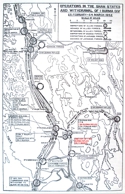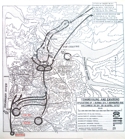7th (Burma Police) Battalion, The Burma Rifles
Formed on 1st November 1940, at Mandalay by Major (acting Lt. Colonel) E.D. McCarthy, from a nucleus of men of the Burma Police and Burma Military Police, the Battalion’s composition was Gurkha, Sikh, Punjabi Mussalman and Burmese. Nine of the British officers were volunteers from the Civil Police, granted emergency commissions into the Army in Burma Reserve of Officers (A.B.R.O.). The remaining three, of whom Major McCarthy was one, were transferred from the Burma Military Police. A number of Governor's Commissioned Officers (G.C.O.s) were also selected and transferred from the Burma Military Police. On 1st November 1940, the British officers, G.C.O.s and N.C.O.s from the Civil and Military Police gathered at Mandalay. They were put through an intensive two month cadre by the Military Police personnel, giving military training to the Civil Police volunteers. On 1st January 1941, volunteers from the three Burma Military Police battalions and the Civil Police assembled and began training.

Officers and G.C.O.s of the 7th (Burma Police) Battalion, The Burma Rifles, 1941
("History of The 7th Burma Police Bn: The Burma Rifles, 1940-1942", National Army Museum)
Click image to open full size in new window
The Battalion came under the command of Upper Burma Area, which was headquartered at Mandalay. The 16th Indian Infantry Brigade moved to Mandalay on arrival from India at the end of November 1941.
On 17th January 1942 the Battalion was ordered to Moulmein, leaving by train on 19th April. Here the Battalion came under command of the 2nd Burma Infantry Brigade Group, at that time under the command of the 17th Indian Infantry Division. The 7th Battalion took up defensive positions on the west, north and east sides of Moulmein, from Ngante on the Ataran River to Mutpun on the Salween.
By the time of the Japanese attack, which began on 30th January 1942, the Battalion was responsible for the defence of the southern part of Moulmein, around the Railway Jetty, and the western and northern river fronts up to a point near the Kyaikpane Jetty. After heavy fighting, orders for a withdrawal across the Salween to Martaban were given by the 2nd Burma Infantry Brigade, timed to begin at 08:00 on 31st January. The 7th Battalion was to embark at three jetties, 'D' Company at the Mission Street Jetty, Headquarters and 'A' Companies from the Railway Jetty and 'B' and 'C' Companies from the Kaladan Jetty. The launch carrying Battalion Headquarters grounded on a sandbank but the officers and men were able to get ashore by wading or swimming before returning with sampans to unload the stores. There were no launches available at Kaladan Jetty and it seems that the men of 'B' and 'C' Companies who escaped to Martaban did so by swimming or floating across the river on rafts. Battalion losses at Moulmein were one British officer missing believed killed, 35 Other Ranks killed in action and around 150 men missing, though many of the latter rejoined some days later, having made their way individually or in small groups.
The Battalion assembled at Thaton and entrained for Hninpale to the North. After three days rest there, on 4th February the Battalion moved to Kyaikto. Defensive positions were prepared and taken up around Kyaikto from 11th February however on 14th February, the Battalion entrained once more as part of the relocation of the 2nd Burma Infantry Brigade to Nyaunglebin. The Brigade had been ordered to join the 1st Burma Infantry Division, tasked with the defence of the Sittang Valley south of Toungoo.
Arriving the next day, the Battalion received a draft of 130 men, mostly Gurkhas and Kumaonis, 15 Karens and some Burmans. The 2nd Burma Infantry Brigade's task was to protect the area Nyaunglebin-Pegu and the 7th Battalion spent the remainder of the month patrolling this area. The Japanese began to arrive in the area at the beginning of March and on 3rd March the Battalion moved northwards to the Thayetkon area. On 11th March, the Battalion supported an attack by the 5th Battalion, 1st Punjab Regiment to capture Shwegyin, on the east bank of the Sittang. The next day the Battalion withdrew, reaching Gonde on 17th March. Here it was reinforced by a company of Kachins from the 3rd Battalion, The Burma Rifles, commanded by Captain Dudley Lincoln. Additional reinforcements were provided by the war posting of 45 Karens of the 4th Battalion, The Burma Rifles, under Captain Ferguson MacDonald.
That day, the Battalion prepared defensive positions astride the road and railway line to Mandalay as part of the force covering the withdrawal northwards of the 1st Burma Infantry Brigade. This brigade passed through in the early hours of the morning of 18th March. A stiff fight with the advancing Japanese began shortly after and lasted until late that night when the Battalion withdrew. The British had now decided to concentrate their forces in the Irrawaddy Valley, leaving the defence of the Toungoo area to the newly arrived Chinese. At 21:30 on the night of 21st March 1942, the 7th Battalion entrained at Kyedaw, north of Toungoo, for Taungdwingyi, which was reached on 23rd March.
By 27th March, the Battalion had moved to Allanmyo, where the 2nd Burma Infantry Brigade was to hold the area, including Thayetmyo on the west bank of the Irrawaddy. Defensive positions were prepared and taken up but on the evening of 2nd April the Battalion left these and crossed the river to Thayetmyo. However, following the decision to withdraw the 17th Indian Infantry Division from the Prome area, the 1st Burma Infantry Division was ordered to withdraw in turn. Allanmyo and Thayetmyo were evacuated on the night of 5th/6th April, with the 7th Battalion providing the rearguard for the 2nd Burma Infantry Brigade. By 15th April, the Battalion had withdrawn in stages to Semigon where orders were received to re-cross the Irrawaddy to Magwe. Despite witnessing enemy aircraft machine gun the river craft, the Battalion crossed unscathed to Magwe during the night of 15th/16th April.
In Magwe, the Battalion was ordered to join 'Magforce', an ad hoc force forming the reserve for the 1st Burma Infantry Division. It was soon realised that the 1st Burma Infantry Division's way north was blocked by Japanese troops who had successfully got through and around the British to establish themselves in a blocking position in Yenangyaung. On 18th April, 'Magforce' launched an attack northwards through Yenangyaung, beginning with the clearing of the Nyaunghla ridge by the 1st Battalion, The Cameronians. The 7th Battalion came under heavy fire after passing through the Cameronians and the 'B' Company commander, Captain MacDonald, late of the 4th Burma Rifles, was killed. Despite pressing additional attacks throughout the day, the 7th Battalion and 'Magforce' were unable to progress. That afternoon, orders were received to bypass the enemy to the east of Yenangyaung and the Battalion joined up with the 1st Burma Infantry Division and the 1st Burma Infantry Brigade near Twingon. Here, 'Magforce' was dispersed.
The Battalion crossed the Pin Chaung the next day, as part of the 1st Burma Infantry Division's escape from Japanese encirclement, and was sent to Mount Popa to rest and reorganise. Losses at Yenangyaung were one British Officer killed in action, one British Officer captured (later confirmed killed), one British Officer wounded, twelve Other Ranks killed, 42 Other Ranks missing, believed prisoners of war, and fifteen Other Ranks missing. On 23rd April, the Battalion moved to Taungtha where 21 men went down with cholera, seventeen of whom died. On 26th April, the Battalion arrived in Myingyan. Here a conference was held by the commanding officers of the Burma Rifles battalions where it was decided the battalions should be withdrawn from the front line. The 7th Battalion, being made up of mostly Gurkhas and Kumaonis, should remain as such however the Battalion’s Kachins and Karens must leave with other battalions. Despite protests by the Battalion Commander, Lt. Colonel E.D. McCarthy, these men left with the 1st Battalion, under the command of Captain Lincoln. On 27th April, the Battalion came under the command of the 13th Indian Infantry Brigade, part of the 1st Burma Infantry Division.
The withdrawal continued, with the 1st Burma Infantry Division headed for Monywa. The Battalion’s role was to protect the brigade transport, by this time mostly consisting of bullock carts. Once again the Japanese got ahead of the British and now occupied Monywa, forcing a change of plan. Whilst the Division fought to clear them out, the 7th Battalion and other units escorted the division transport around Monywa to the east and arrived safely in Alon on 3rd May. From here, the Battalion headed north to Shwegyin, where on the night of 8th/9th May it crossed the Chindwin. The withdrawal proceeded slowly towards India. Tamu was reached on 17th May 1942, followed by a halt for two days at Palel. On 20th May, the Battalion left in pouring rain for Imphal where it remained in camp at Milestone 109 on the Imphal-Dimapur road until late June.
On 24th June 1942, the 7th and 8th Battalions left together for Ranchi by train and river steamer. From here, the men made their way to Hoshiarpur, where the remnants of the Burma Army were being assembled.
Reorganisation proceeded slowly. About 400 Burmese men of the Burma Rifles were available together with about 10,000 men from the Burma Frontier Force, Burma Military Police and Indian other ranks of the 7th and 8th Battalions, The Burma Rifles. It was estimated that after weeding, about 7,000 of these men would be available for further duty of which 5,000 were suitable for active service and the remainder for garrison battalion duties. The 7th and 8th Battalions had been formed from Gurkha and Indian members of the Burma Frontier Force and Military Police in 1940 when the Burma Rifles was expanded urgently, given the growing threat of war with Japan. On arrival in India, the 7th Battalion had about 300 men, mostly Gurkhas and Kumaonis formerly of the Burma Military Police, and the 8th Battalion about 400 men, Punjabi Mussalmen and Sikhs, formerly of the Burma Frontier Force. General Headquarters India proposed amalgamating the two battalions, expecting that the new unit would then serve as a regular infantry battalion in an Indian division. The Government of Burma was uncomfortable with this and preferred to see the men returned to the Burma Frontier Force and Burma Military Police pool. Despite an initial intention to retain the identities of these battalions, in the end the men of the 7th and 8th Battalions, The Burma Rifles were formed into the 1st Battalion, The Burma Regiment from 1st September 1942.
[The war diary of the battalion was destroyed during the retreat and was later reconstructed following arrival in India. The file is available at the National Archives at Kew as WO 172/979. A transcription of the file, together with extensive footnotes gleaned from other sources, can be read or downloaded here.]
06 November 2017



